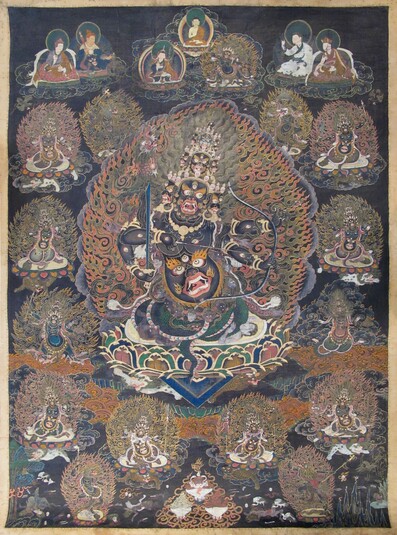
Item: Rahula (Buddhist Protector)
| Origin Location | Tibet |
|---|---|
| Date Range | 1700 - 1799 |
| Lineages | Nyingma and Buddhist |
| Material | Ground Mineral Pigment, Black Background on Cotton |
| Collection | Rubin Museum of Art |
Classification: Deity
Rahula (Tibetan: kyab jug): wrathful protector of the Revealed Treasure Tradition of the Nyingma School of Tibetan Buddhism. (See the Rahula Main Page and Outline Page).

Fiercely wrathful, black in colour, with nine heads, each face has three large eyes and a gaping mouth with exposed fangs. The faces are all black and stacked. On the stomach is the large face of the original Rahula who devoured the nine celestial planets. The body is covered with numerous eyes. In the first pair of hands are a drawn bow and arrow. The second right holds aloft a sword with an impaled Makara head and the left a snake lasso. Adorned with crowns of five skulls and gold earrings he wears a black scarf and an elephant and human skin as lower garments. The lower body is that of a coiled naga serpent, green in colour. He stands atop two prone human bodies, a sun disc, muli-coloured lotus and a black triangle enclosure supported by a tiger and snow lion; surrounded by orange flames and black smoke. Rahula is surrounded by fourteen retinue figures either in the same appearance as the central figure or with animal heads.
"From a fierce E [syllable] in a realm equal to space, the Lord arises out of wrathful activity, smoky, with nine heads, four hands and a thousand blazing eyes; homage to the Great Rahula - Protector of the Teachings." (Nyingma liturgical verse).
At the top center is Shakyamuni Buddha, Padmasambhava and a wrathful form of Vajrapani. In the fierce form Vajrapani typically has one face and two hands with the right arm outstretched and holding a vajra scepter ready to throw at enemies and obstacles. The left hand usually holds a vajra lasso or is simply in a wrathful gesture. In this appearance there is the added attribute of a garuda bird slightly above the left hand. This is significant. The colour of the bird often indicates which 'Terma' Revealed Treasure tradition the Vajrapani originates from thus allowing for the identification of the Terton and the larger cycle of teachings associated with this particular Vajrapani and the protector Rahula in a fifteen deity configuration.
Aside from the special 'Terma' connection, it is also common for Vajrapani in wrathful form to appear in paintings (at the top) depicting worldly, not yet enlightened, protector deities. Vajrapani is there as a kind of seal or a reminder to the worldly deity that he or she is still being watched and monitored by an enlightened power. In the Nyingma tradition the protector Rahula is considered extremely ferocious and terrifying. He is believed to cause the physical affliction of strokes on those practitioners that do not perform the rituals correctly or in a timely manner.
Again at the top of the composition, on the viewer's left are Padma Ledral Tsal (birth 1248 or 1291-1315 or 1231/2-1307) and Shang Trom Dorje Obar (considered an incarnation of Nubchen Sanggye Yeshe). On the right side are Rigdzin Ngaggi Wangpo (1580-1639) - founder of Dorje Drag Monastery in Central Tibet and lastly Ngagwang Padma Kunzang Tegchog (16th/17th century).
The name Rahula belongs to three important figures in Buddhist iconography. The (1) first use is as the proper name for the biological son, Rahula, of Gautama - Shakyamuni Buddha. The (2) second use of the name is for the Indian cosmological deity Rahula, the deification of the phenomenon of an eclipse. The (3) third use of Rahula is for the horrific Nyingma protector deity, wrathful, with nine heads and a giant face on the belly. It is likely that this Buddhist protector is a Tibetan creation and not linked to any Sanskrit literature or Indian religious tradition. Aside from these three uses of the name there were also numerous Indian pandits and siddhas with the name Rahula, Rahula Bhadra, Rahula Gupta, etc.
The Tibetan protector deity is based on the Indian deity Rahula, an ancient Indian god, a demi-god, of the cosmos, related to the eclipse of the sun, moon and other planets. In the ancient tradition of Tibetan Buddhism (Nyingma) Rahula became popular as a protector of the 'revealed treasure' teachings (terma). In Buddhist depictions he is portrayed with the lower body of a coiled serpent spirit (naga) and the upper body with four arms, nine heads, adorned with a thousand eyes. In the middle of the stomach is one large wrathful face. The face in the stomach, belly, is actually the face and head of Rahula. The nine stacked heads depicted above are the nine planets that Rahula has eclipsed, or rather literally swallowed, eaten and now symbolically appear on top of his own face and insatiable mouth. At the crown of the stack of all the heads is the head of a black raven.
Although sometimes found in various Kagyu Schools and occasionally in the Gelug especially when associated with a particular Nyingma 'Terma' adopted by that tradition. Generally speaking the protector deity Rahula remains essentially a Nyingma Tradition practice associated with the Revealed Treasure Tradition and not commonly found in most of the other Tibetan Buddhist Schools. Rahula in the Nyingma form is alsmost unheard of in the Sakya Tradition and related schools.
Jeff Watt 9-2010
Front of Painting
English Translation of Inscription: [Name inscriptions for the four Tibetan teachers at the top of the composition]
Bibliography: Protector Deities in Himalayan Art (Buddhist)
Thematic Sets
Buddhist Deity: Rahula - Main Figure (Painting)
Collection of Rubin Museum of Art: Painting Gallery 4
Buddhist Worldly Protector: Rahula Main Page
Collection of RMA: Black Ground Masterworks
Buddhist Worldly Protector: Rahula (Masterworks)
Subject: Protector Deities Main Page (All Traditions)






